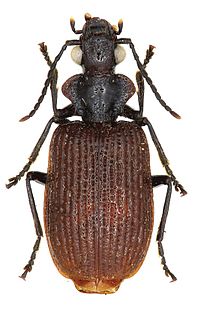
The Yangtze or Yangzi is the longest river in Asia, the third-longest in the world and the longest in the world to flow entirely within one country. It rises in the northern part of the Tibetan Plateau and flows 6,300 km (3,900 mi) in a generally easterly direction to the East China Sea. It is the sixth-largest river by discharge volume in the world. Its drainage basin comprises one-fifth of the land area of China, and is home to nearly one-third of the country's population.

The giant panda, also known as panda bear or simply panda, is a bear native to south central China. It is easily recognized by the large, distinctive black patches around its eyes, over the ears, and across its round body. The name "giant panda" is sometimes used to distinguish it from the red panda. Though it belongs to the order Carnivora, the giant panda is a folivore, with bamboo shoots and leaves making up more than 99% of its diet. Giant pandas in the wild will occasionally eat other grasses, wild tubers, or even meat in the form of birds, rodents, or carrion. In captivity, they may receive honey, eggs, fish, yams, shrub leaves, oranges, or bananas along with specially prepared food.

Hamsters are rodents belonging to the subfamily Cricetinae, which contains 18 species classified in seven genera. They have become established as popular small house pets. The best-known species of hamster is the golden or Syrian hamster, which is the type most commonly kept as pets. Other hamster species commonly kept as pets are the three species of dwarf hamster, Campbell's dwarf hamster, the winter white dwarf hamster and the Roborovski hamster.

Magnolia is a large genus of about 210 flowering plant species in the subfamily Magnolioideae of the family Magnoliaceae. It is named after French botanist Pierre Magnol.

The Yellow River or Huang He is the second longest river in China, after the Yangtze River, and the sixth longest river system in the world at the estimated length of 5,464 km (3,395 mi). Originating in the Bayan Har Mountains in Qinghai province of Western China, it flows through nine provinces, and it empties into the Bohai Sea near the city of Dongying in Shandong province. The Yellow River basin has an east–west extent of about 1,900 kilometers (1,180 mi) and a north–south extent of about 1,100 km (680 mi). Its total drainage area is about 752,546 square kilometers (290,560 sq mi).

The cicadas are a superfamily, the Cicadoidea, of insects in the order Hemiptera. They are in the suborder Auchenorrhyncha, along with smaller jumping bugs such as leafhoppers and froghoppers. The superfamily is divided into two families, Tettigarctidae, with two species in Australia, and Cicadidae, with more than 3,000 species described from around the world; many species remain undescribed.

Sorghum is a genus of flowering plants in the grass family Poaceae. Seventeen of the 25 species are native to Australia, with the range of some extending to Africa, Asia, Mesoamerica, and certain islands in the Indian and Pacific Oceans. One species is grown for grain, while many others are used as fodder plants, either cultivated in warm climates worldwide or naturalized, in pasture lands. Sorghum is in the subfamily Panicoideae and the tribe Andropogoneae.

Carp are various species of oily freshwater fish from the family Cyprinidae, a very large group of fish native to Europe and Asia.

Hydrangea is a genus of 70–75 species of flowering plants native to Asia and the Americas. By far the greatest species diversity is in eastern Asia, notably Korea, China, and Japan. Most are shrubs 1 to 3 meters tall, but some are small trees, and others lianas reaching up to 30 m (98 ft) by climbing up trees. They can be either deciduous or evergreen, though the widely cultivated temperate species are all deciduous.

Gibbons are apes in the family Hylobatidae. The family historically contained one genus, but now is split into four genera and 18 species. Gibbons live in tropical and subtropical rainforests from eastern Bangladesh and northeast India to southern China and Indonesia.

Hornbeams are hardwood trees in the flowering plant genus Carpinus in the birch family Betulaceae. The 30–40 species occur across much of the temperate regions of the Northern Hemisphere.

Buxus is a genus of about 70 species in the family Buxaceae. Common names include box or boxwood.

The hazel (Corylus) is a genus of deciduous trees and large shrubs native to the temperate Northern Hemisphere. The genus is usually placed in the birch family Betulaceae, though some botanists split the hazels into a separate family Corylaceae. The fruit of the hazel is the hazelnut.

The Agelenidae are a large family of spiders in the suborder Araneomorphae. Well-known examples include the common "grass spiders" of the genus Agelenopsis. Nearly all Agelenidae are harmless to humans, but the bite of the hobo spider may be medically significant, and some evidence suggests it might cause necrotic lesions. However, the matter remains subject to debate. The most widely accepted common name for members of the family is funnel weaver.

The peony or paeony is a flowering plant in the genus Paeonia, the only genus in the family Paeoniaceae. They are native to Asia, Europe and Western North America. Scientists differ on the number of species that can be distinguished, ranging from 25 to 40, although the current consensus is 33 known species. The relationships between the species need to be further clarified.

The baiji is a type of freshwater dolphin thought to be the first dolphin species driven to extinction due to the impact of humans. Nicknamed "Goddess of the Yangtze". Since Baiji means 'white' in Chinese, it means 'white dolphin'. In China, the dolphin is also called Chinese river dolphin, Yangtze River dolphin, whitefin dolphin and Yangtze dolphin. It was regarded as the goddess of protection by local fishermen and boatmen in China. It is not to be confused with the Chinese white dolphin or the finless porpoise.

An endangered species is a species which has been categorized as very likely to become extinct in the near future. Endangered (EN), as categorized by the International Union for Conservation of Nature (IUCN) Red List, is the second most severe conservation status for wild populations in the IUCN's schema after Critically Endangered (CR).

The flora of China is diverse. More than 30,000 plant species are native to China, representing nearly one-eighth of the world's total plant species, including thousands found nowhere else on Earth.

























